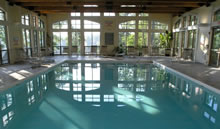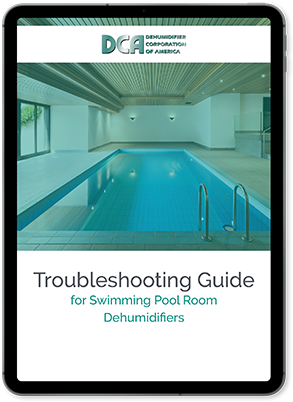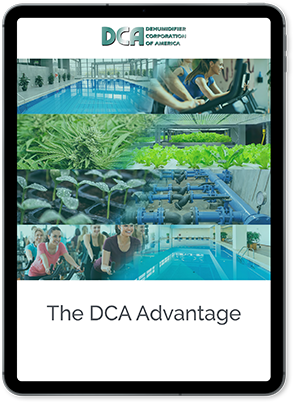In humid climates, outdoor dehumidifiers are a practical solution for creating a more comfortable indoor environment. These versatile systems can be ducted into the air handling unit (AHU) or placed directly in the room, if necessary. As they remove the stale or odor-filled air from a home, office, or other space, they dehumidify the make-up air as it’s drawn in.
Recent Posts
Dehumidification systems remove unwanted moisture from a building’s internal environment to help control its atmosphere’s relative humidity and dew point. In commercial applications, dehumidifiers help contribute to a pleasant work environment, aid in room temperature regulation, and help control condensation causing mold or mildew formation. In industrial applications, dehumidification systems aid in controlling your product’s moisture content, enable smooth process operations, and maximize production efficiency.
At the Dehumidifier Corporation of America (DCA), our engineers frequently come across pool room dehumidification systems that have not been consistently or effectively maintained.
High turnover is common among pool room maintenance personnel — particularly in hotels, motels, and other hospitality-industry facilities — but to ensure optimal safety, performance, and longevity, it’s essential to establish a comprehensive dehumidification system maintenance plan that adheres to manufacturer recommendations.
In order to remain functional, comfortable, and safe, swimming pool areas must be equipped with high-quality, reliable dehumidification systems. As with any complex system, pool room dehumidification equipment requires regular maintenance and, periodically, replacement.
Determining whether replacement is the appropriate action, however, can be daunting or confusing, as diagnosing problems is often a complex process in itself. And once system issues have been identified, an operator must determine which course of action will best rectify them: repair, retrofit, or complete replacement.
Although dehumidifiers are built to endure harsh environments, the average lifespan of a dehumidifier used for industrial and institutional applications is nine to eleven years. It is typically more expensive to keep an aging unit instead of simply replacing the dehumidifier altogether.
At Dehumidifier Corporation of America, we can easily replace an obsolete dehumidifier. With the help of our team of experts, we can help you choose the exact replacement dehumidifier you’re looking for based on your requirements.
Vertical farming is an agricultural method in which crops such as leafy greens and herbs are farmed indoors within climate-controlled environments. As the process becomes more efficient and economically viable, these urban farms are becoming more prevalent across the United States.
By controlling important environmental factors indoors, growers are able to cultivate better-quality crops at higher yields and in shorter periods of time. This also reduces the human footprint on the environment, as water and nutrients are conserved and less pollution and emissions are generated.
Whether using dehumidification for industrial, commercial, residential, or swimming pool applications, customers must determine, if applicable, which of the two typical cooling system options will be the best fit for their application — air cooled or water cooled.

Air cooled dehumidifiers, for indoor pool room dehumidification and other projects, are the most common type and deliver warm dry air back to the space when operating. When room cooling is needed they are coupled with an optional outdoor remote condenser. This allows them to deliver warm dry air or cool dry air depending on what the controls call for.
Humidity is a major concern for all indoor swimming pool owners. Air-to-air heat exchangers and ventilation systems were commonly used to control pool room humidity.
 These methods are expensive to operate and wasteful, in that they constantly exhaust previously heated or cooled air outdoors. They also often fail to prevent structural damage caused by excess moisture, as the formation of mold and mildew in cold walls can cause irreparable damage.
These methods are expensive to operate and wasteful, in that they constantly exhaust previously heated or cooled air outdoors. They also often fail to prevent structural damage caused by excess moisture, as the formation of mold and mildew in cold walls can cause irreparable damage.
The most effective way to control pool room humidity is to use a full dehumidification system that serves to remove destructive moisture and add room heating as a by-product of the dehumidification cycle.
Hotel, motel, and residential indoor pool rooms are just a few scenarios where you can find dehumidification systems controlling the relative humidity. An unexpected failure of a dehumidification system in these facilities can have some considerable negative impacts.
 A malfunctioning dehumidification system can cause mold and mildew build up quickly. This can lead to musty smells and poor air quality, not to mention structural issues.
A malfunctioning dehumidification system can cause mold and mildew build up quickly. This can lead to musty smells and poor air quality, not to mention structural issues.
Malfunctioning dehumidification systems can also lead to unhappy customers and bad reviews, which could hurt a business. In an industrial setting, a manufacturer can lose a large amount of money in downtime, missed deadlines, or ruined product when relative humidity is out of control.
The mission of Dehumidifier Corporation of America (DCA) has been to provide customers with high quality dehumidification systems solutions at competitive prices. That has been our primary goal since our founding in 1995.
DCA has always provided the highest quality brand name, off-the-shelf, non-proprietary dehumidifier components, easily obtained from any quality refrigeration distributor. This is especially important when it comes to the control system. DCA has never specified proprietary controls on any of our products. This allows repair technicians the advantage of sourcing controls and many other dehumidifier parts from their local supply house, as opposed to waiting for the factory to react.



